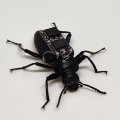A killer that devours its victims through its nose may sound more like a horror film character than a potential friend of Australian agriculture, but with the help of University of Queensland research it may be cast in a new role.
Enter the Australian assassin bug - the subject of PhD student Paul Grundy's research in the Plant Production Department at the University's Gatton College.
Mr Grundy is researching one of many species of the bug and its potential as a biological control agent in a variety of oil seed crops.
The assassin bug is a generalist predator which, during its development to adult stage, eats 17 times its own weight, with a preference for caterpillars and most bug insects.
The assassin bug slowly stalks its prey from behind, then injects it with an enzyme (protyletic saliva) to break down the victim's tissue.
'The enzyme almost purees the victim's tissue which is sucked through the assassin bug's proboscis - all that remains is the dead insect's shell,' Mr Grundy said.
'Its voracious appetite makes it ideal for the agricultural industry's integrated pest management (IPM) approach.'
Mr Grundy's main aim is to implement an IPM program for farmers - introducing the insect to attack particular crop pests while integrating safe chemicals that are used to kill crop pests that the bug does not eat.
He said the proposed use of the bug would not have harmful effects, unlike the experience of some biological controls such as cane toads.
Mr Grundy said the research would benefit growers of many crops because the hardy bug was prevalent throughout Queensland and New South Wales.
'The bug will eventually be released on cotton, canola and sunflowers,' he said. 'Scope also exists at the end of the research to make similar use of the bug on horticultural crops including citrus, tomatoes, capsicum and tree crops.'
'Companies have shown interest in using the species and its commercialisation will be developed.'
Mr Grundy said insect pests reached plague proportions on sunflower crops in the Lockyer Valley in South-West Queensland last year.
The study will involve releasing the bug to protect canola crops from cabbage moth, and sunflower crops from the heliothis caterpillar, green vegetable bug and rutherglen bug.
Mr Grundy, who graduated bachelor of horticultural technology with first class honors from the University last year, is supervised by Dr Errol Hassan.
He has received a $26,000 grant from the Grains Research and Development Corporation (GRDC) to continue the research he began as an undergraduate.
He won the W. W. Bryan medal from the Australian Institute of Agricultural Science, the Westpac Bank Award and the Faulding Imaging Keith Dove Memorial Prize, all for the best fourth-year thesis of 1996 in the School of Land and Food Systems at Gatton College.
His thesis involved breeding about 5000 assassin bugs from a pool of five over a six-month period and studying the bug's predatory habits, survival rates, development times, life cycle, sex life and growth.
Mr Grundy said the mass rearing of the bug involved feeding thousands of host grubs and insects.
He also spent six months' work placement as part of his degree with a Queensland company specialising in biological control and integrated pest management.
For more information, contact Mr Grundy (telephone 07 5460 1281).
.jpg)

